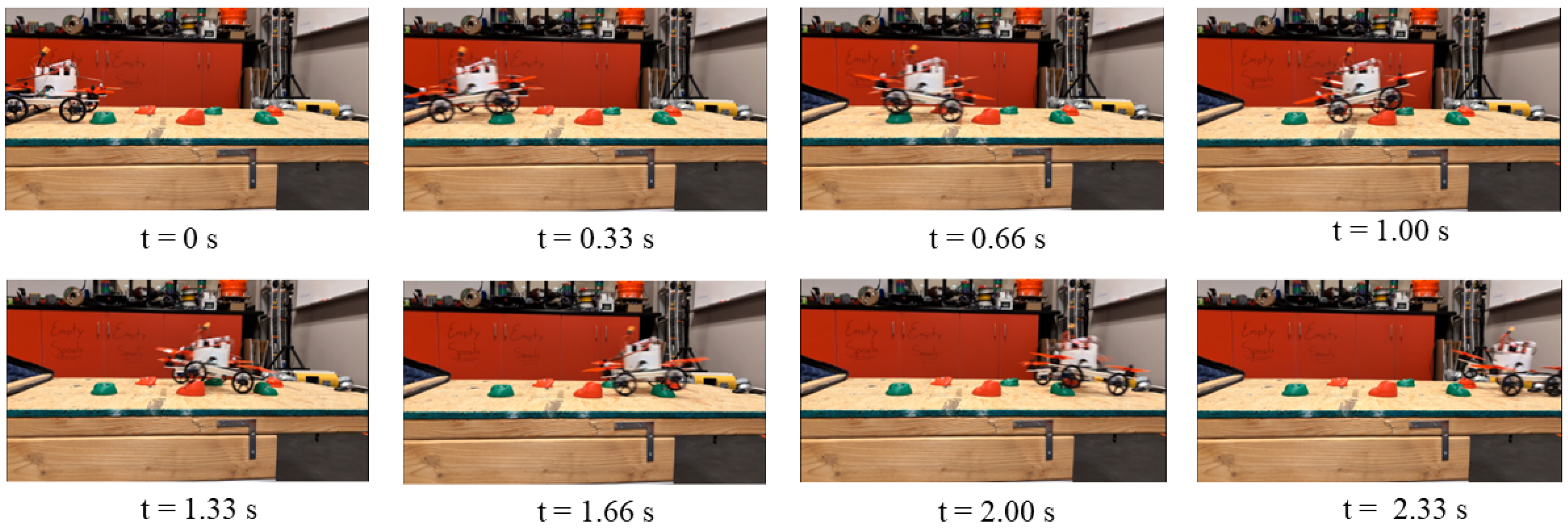To Boldly Go: Redefining Mobility with Thrust-Augmented Rocker-Bogie CanBots for Simulated Planetary Exploration
Abstract
1. Introduction
1.1. Historical Planetary Exploration
1.2. Multimodal Mobility
1.3. Multimodal in Space
- Development of fully homogeneous multimodal locomotion technique targeted for deployment in planetary surface environments;
- Significantly improved capacity for rocker-bogie system to climb inclines well beyond any previous rover configurations;
- Unique hybrid locomotion mechanism that allowed for fully inverted operation of a rocker bogie.
2. Materials and Methods
2.1. CanBots
2.2. Initial Multimodal CanBot
2.3. Heterogeneous Design Development
2.4. Homogeneous Design Development
2.5. Wheel Slippage Testing
2.5.1. ATAT Table
2.5.2. Motion Capture
3. Results
3.1. Heterogeneous CanBot Results
3.1.1. Heterogeneous Mobility Validation
3.1.2. Heterogeneous Wheel Slippage
3.2. Homogeneous CanBot Results
3.2.1. Homogeneous Mobility Validation
3.2.2. Homogeneous Wheel Slippage
3.2.3. Power Logging
4. Discussion
Future Directions
5. Conclusions
Author Contributions
Funding
Data Availability Statement
Acknowledgments
Conflicts of Interest
Abbreviations
| AGAR | Air–Ground Amphibious Robot |
| ATAT-Table | Analogous Terrain and Tilt Table |
| COT | Cost Of Transport |
| COTS | Commercial Off-The-Shelf |
| ESC | Electronic Speed Controller |
| FC | Flight Controller |
| FE | Falling Edge |
| HEARALD | Hybrid Exploration Robot for Air and Land Deployment |
| JPL | Jet Propulsion Laboratory |
| M4 | Multi-Modal Mobility Morphobot |
| MER | Mars Exploration Rover |
| MoCap | Motion Capture |
| MSL | Mars Science Laboratory |
| NASA | National Aeronautics and Space Administration |
| NIAC | Innovative Advanced Concepts Program |
| OSB | Oriented Strand Board |
| PID | Proportional–Integral–Derivative |
| RE | Rising Edge |
| RF | Radio Frequency |
| SFH | Sample Fetch Helicopter |
| TARB | Thrust-Augmented Rocker Bogie |
| USSR | Union of Soviet Socialist Republics |
Appendix A
Appendix A.1
| Table Angle (measured by) | Climb Mode | Measured Distance | Wheel Slippage |
|---|---|---|---|
| −0.30° (MoCap) | No Thrust | 0.31 m | 1.28% |
| 4.70° (MoCap) | No Thrust | 0.28 m | 8.83% |
| 9.20° (MoCap) | No Thrust | 0.27 m | 13.4% |
| 13.0° (MoCap) | No Thrust | 0.25 m | 18.0% |
| 17.7° (MoCap) | No Thrust | 0.23 m | 27.4% |
| 22.9° (MoCap) | Thrust | 0.24 m | 22.9% |
| 29.9° (MoCap) | Thrust | 0.22 m | 29.0% |
| 40.7° (MoCap) | Thrust | 0.20 m | 36.3% |
| Table Angle (Measured by) | Climb Mode | Measured Distance | Wheel Slippage |
|---|---|---|---|
| 1.00° (MoCap) | No Thrust | 0.46 m | 0% |
| 4.60° (MoCap) | No Thrust | 0.42 m | 9.16% |
| 10.2° (MoCap) | No Thrust | 0.38 m | 16.8% |
| 15.1° (MoCap) | No Thrust | 0.34 m | 25.7% |
| 20.1° (MoCap) | No Thrust | 0.29 m | 36.3% |
| 25.4° (MoCap) | No Thrust | 0.19 m | 58.5% |
| 30.1° (MoCap) | No Thrust | 0.12 m | 74.0% |
| 29.3° (MoCap) | Thrust | 0.27 m | 42.2% |
| 33.8° (MoCap) | Thrust | 0.25 m | 45.8% |
| 40.0° (MoCap) | Thrust | 0.21 m | 53.6% |
| 44.9° (MoCap) | Thrust | 0.18 m | 60.7% |
| 50.5° (MoCap) | Thrust | 0.17 m | 63.8% |
| 56.1° (MoCap) | Thrust | 0.08 m | 81.7% |
| 59.9° (MoCap) | Thrust | 0.06 m | 86.9% |
| 70° (Inclinometer) | Thrust | 0 m | 100% |
| 80° (Inclinometer) | Thrust | 0 m | 100% |
| 90° (Inclinometer) | Thrust | 0 m | 100% |
References
- NASA. Space Technology Grand Challenges. Available online: https://schools.sciencenorth.ca/sites/default/files/inline-files/Space-Technology-Grand-Challenges.pdf (accessed on 9 October 2025).
- Boston, P.J.; Frederick, R.D.; Hildreth-Werker, V. Extraterrestrial Caves: Science, Habitat, and Resources (a NIAC Phase I Study). 2003. Available online: https://digitalcommons.usf.edu/kip_data/76/?utm_source=digitalcommons.usf.edu%2Fkip_data%2F76&utm_medium=PDF&utm_campaign=PDFCoverPages (accessed on 13 November 2023).
- Blamont, J. A roadmap to cave dwelling on the Moon and Mars. Adv. Space Res. 2014, 54, 2140–2149. [Google Scholar] [CrossRef]
- Ellery, A. Planetary Rovers: Robotic Exploration of the Solar System; Springer Praxis Books Astronautical Engineering, Praxis; Springer: Berlin/Heidelberg, Germany, 2016. [Google Scholar]
- Baker, D. NASA Mars Rovers: 1997–2013 (Sojourner, Spirit, Opportunity and Curiousity): An Insight into the Technology, History, and Development of NASA’s Mars Exploration Roving Vehicles; Owners’ Workshop Manual, Haynes Publishing: Somerset, UK, 2013. [Google Scholar]
- Verma, V.; Maimone, M.W.; Gaines, D.M.; Francis, R.; Estlin, T.A.; Kuhn, S.R.; Rabideau, G.R.; Chien, S.A.; McHenry, M.M.; Graser, E.J.; et al. Autonomous robotics is driving Perseverance rover’s progress on Mars. Sci. Robot. 2023, 8, eadi3099. [Google Scholar] [CrossRef] [PubMed]
- NASA/JPL. PIA01122: Sojourner Rover Near “The Dice”. 1997. Available online: https://photojournal.jpl.nasa.gov/catalog/PIA01122 (accessed on 9 February 2024).
- Chun, C. Advanced Multimodal Planetary Surface Exploration for Scientific CanBots. 2025. Available online: https://digitalcommons.kennesaw.edu/dissertations/117/ (accessed on 9 October 2025).
- Harrington, B.D.; Voorhees, C. The challenges of designing the rocker-bogie suspension for the mars exploration rover. In Proceedings of the 37th Aerospace Mechanisms Symposium, Galveston, TX, USA, 19–21 May 2004. [Google Scholar]
- Chen, Z.; Zou, M.; Pan, D.; Chen, L.; Liu, Y.; Yuan, B.; Zhang, Q. Study on climbing strategy and analysis of Mars rover. J. Field Robot. 2023, 40, 1172–1186. [Google Scholar] [CrossRef]
- Cordes, F.; Kirchner, F.; Babu, A. Design and field testing of a rover with an actively articulated suspension system in a Mars analog terrain. J. Field Robot. 2018, 35, 1149–1181. [Google Scholar] [CrossRef]
- Cao, C.; Rogg, A.; Tardy, A. Actuated Suspension Tuning Characterization of the VIPER Lunar Rover. In Proceedings of the 2023 IEEE Aerospace Conference, Big Sky, MT, USA, 4–11 March 2023; IEEE: Piscataway, NJ, USA, 2023; pp. 1–11. [Google Scholar] [CrossRef]
- Zhang, T.; Peng, S.; Jia, Y.; Tian, H.; Sun, J.; Yan, C. Slip Estimation for Mars Rover Zhurong Based on Data Drive. Appl. Sci. 2022, 12, 1676. [Google Scholar] [CrossRef]
- Tzanetos, T.; Aung, M.; Balaram, J.; Grip, H.F.; Karras, J.T.; Canham, T.K.; Kubiak, G.; Anderson, J.; Merewether, G.; Starch, M.; et al. Ingenuity Mars Helicopter: From Technology Demonstration to Extraterrestrial Scout. In Proceedings of the 2022 IEEE Aerospace Conference (AERO), Big Sky, MT, USA, 5–12 March 2022; IEEE: Piscataway, NJ, USA, 2022; pp. 1–19. [Google Scholar] [CrossRef]
- Grip, H.F.; Conway, D.; Lam, J.; Williams, N.; Golombek, M.P.; Brockers, R.; Mischna, M.; Cacan, M.R. Flying a Helicopter on Mars: How Ingenuity’s Flights were Planned, Executed, and Analyzed. In Proceedings of the 2022 IEEE Aerospace Conference (AERO), Big Sky, MT, USA, 5–12 March 2022; IEEE: Piscataway, NJ, USA, 2022; pp. 1–17. [Google Scholar] [CrossRef]
- Radotich, M.; Withrow-Maser, S.; deSouza, Z.; Gelhar, S.; Gallagher, H. A study of past, present, and future mars rotorcraft. In Proceedings of the 9th Biennial Autonomous VTOL Technical Meeting, Online, 26–28 January 2021. [Google Scholar]
- NASA and JPL-Caltech. Ingenuity Picture, Mastcam-Z Gives Ingenuity a Close-up. 2021. Available online: https://www.jpl.nasa.gov/images/pia24547-mastcam-z-gives-ingenuity-a-close-up (accessed on 9 October 2024).
- Kalantari, A.; Touma, T.; Kim, L.; Jitosho, R.; Strickland, K.; Lopez, B.T.; Agha-Mohammadi, A.A. Drivocopter: A concept Hybrid Aerial/Ground vehicle for long-endurance mobility. In Proceedings of the 2020 IEEE Aerospace Conference, Big Sky, MT, USA, 7–14 March 2020; IEEE: Piscataway, NJ, USA, 2020; pp. 1–10. [Google Scholar] [CrossRef]
- Latscha, S.; Kofron, M.; Stroffolino, A.; Davis, L.; Merritt, G.; Piccoli, M.; Yim, M. Design of a Hybrid Exploration Robot for Air and Land Deployment (H.E.R.A.L.D) for urban search and rescue applications. In Proceedings of the 2014 IEEE/RSJ International Conference on Intelligent Robots and Systems, Chicago, IL, USA, 14–18 September 2014; IEEE: Piscataway, NJ, USA, 2014; pp. 1868–1873. [Google Scholar] [CrossRef]
- Wang, Y.; Zhang, N.; Pan, B.; Su, B.; Li, S. Multi-mode Motion Control System Design and Implementation for an Air-ground Amphibious Robot. In Proceedings of the 2021 China Automation Congress (CAC), Beijing, China, 22–24 October 2021; IEEE: Piscataway, NJ, USA, 2021; pp. 7751–7756. [Google Scholar] [CrossRef]
- Zhang, D.; Guo, C.; Ren, H.; Zhu, P.; Xu, M.; Lu, H. The Design of an Aerial/Ground Dual-modal Mobile Robot for Exploring Complex Environments. In Proceedings of the 2021 IEEE International Conference on Real-time Computing and Robotics (RCAR), Xining, China, 15–19 July 2021; IEEE: Piscataway, NJ, USA, 2021; pp. 393–398. [Google Scholar] [CrossRef]
- Kaneki, S.; Yokota, S.; Chugo, D.; Hashimoto, H. Development of underacuated hybrid mobile robot composed of rotors and wheel. In Proceedings of the 2018 IEEE International Conference on Industrial Technology (ICIT), Lyon, France, 20–22 February 2018; IEEE: Piscataway, NJ, USA, 2018; pp. 1961–1966. [Google Scholar] [CrossRef]
- Premachandra, C.; Otsuka, M. Development of hybrid aerial/terrestrial robot system and its automation. In Proceedings of the 2017 IEEE International Systems Engineering Symposium (ISSE), Vienna, Austria, 11–13 October 2017; IEEE: Piscataway, NJ, USA, 2017; pp. 1–3. [Google Scholar] [CrossRef]
- Sihite, E.; Kalantari, A.; Nemovi, R.; Ramezani, A.; Gharib, M. Multi-Modal Mobility Morphobot (M4) with appendage repurposing for locomotion plasticity enhancement. Nat. Commun. 2023, 14, 3323. [Google Scholar] [CrossRef] [PubMed]
- David, N.B.; Zarrouk, D. Design and Analysis of FCSTAR, a Hybrid Flying and Climbing Sprawl Tuned Robot. IEEE Robot. Autom. Lett. 2021, 6, 6188–6195. [Google Scholar] [CrossRef]
- Pipenberg, B.T.; Langberg, S.A.; Tyler, J.D.; Keennon, M.T. Conceptual Design of a Mars Rotorcraft for Future Sample Fetch Missions. In Proceedings of the 2022 IEEE Aerospace Conference (AERO), Big Sky, MT, USA, 5–12 March 2022; IEEE: Piscataway, NJ, USA, 2022; pp. 1–14. [Google Scholar] [CrossRef]
- Withrow-Maser, S.; Johnson, W.; Tzanetos, T.; Grip, H.; Koning, W.; Schatzman, N.; Young, L.; Chan, A.; Ruan, A.; Cummings, H.; et al. Mars Sample Recovery Helicopter: Rotorcraft to Retrieve the First Samples from the Martian Surface. In Proceedings of the Vertical Flight Society’s 79th Annual Forum & Technology Display (Forum 79), West Palm Beach, FL, USA, 16–18 May 2023. [Google Scholar]
- Chun, C.; Tanveer, M.H.; Chakravarty, S. The CanSat Compendium: A Review of Scientific CanSats. Machines 2023, 11, 675. [Google Scholar] [CrossRef]
- Koo, K.W.; Kim, H.D. Trends in Development of Micro Rovers for Planetary Exploration. J. Space Technol. Appl. 2023, 3, 213–228. [Google Scholar] [CrossRef]
- Williams, D.R. Smart Lander for Investigating Moon.; 2022. Available online: https://nssdc.gsfc.nasa.gov/nmc/spacecraft/display.action?id=2023-137D (accessed on 7 February 2024).
- Brett Tingley. Mexico’s 1st Moon Mission will Send 5 Tiny Robots Aloft on Peregrine Lunar Lander 8 January 2024. Available online: https://www.space.com/peregrine-lunar-lander-mexico-colmena-micro-robots (accessed on 9 February 2024).
- Astrobotic. ASTROBOTIC CUBEROVER: Payload User’s Guide. 2024. Available online: https://www.astrobotic.com/wp-content/uploads/2024/01/Astrobotic_CubeRover-PUG_V2-2.pdf (accessed on 7 February 2024).
- Chun, C.; Patel, U.; Tanveer, M.H.; Swift, T.; Dallesasse, K.; Chakravarty, S. Crafting CanSats: A Novel Modular Design Paradigm for Scientific CanSats. In Proceedings of the 2023 IEEE 20th International Conference on Smart Communities: Improving Quality of Life using AI, Robotics and IoT (HONET), Boca Raton, FL, USA, 4–6 December 2023; IEEE: Piscataway, NJ, USA, 2023; pp. 68–72. [Google Scholar] [CrossRef]
- Chun, C.; Angulo, A.M.; Tanveer, M.H.; Chakravarty, S. Modular Multimodal CanBot Trajectory Tracking with Optical Motion Capture System. In Proceedings of the 2024 9th International Conference on Automation, Control and Robotics Engineering (CACRE), Jeju Island, Republic of Korea, 18–20 July 2024; IEEE: Piscataway, NJ, USA, 2024; pp. 363–368. [Google Scholar] [CrossRef]
- Chun, C. MARS Lab: TARB. MARS Laboratories. 2025. Available online: https://carychun1.wixsite.com/mars-lab/tarb (accessed on 28 October 2025).
- Lindemann, R. Dynamic Testing and Simulation of the Mars Exploration Rover. In Proceedings of the 5th International Conference on Multibody Systems, Nonlinear Dynamics, and Control, Parts A, B, and C. ASMEDC, Long Beach, CA, USA, 24–28 September 2005; Volume 6, pp. 99–106. [Google Scholar] [CrossRef]
- Heverly, M.; Matthews, J.; Lin, J.; Fuller, D.; Maimone, M.; Biesiadecki, J.; Leichty, J. Traverse Performance Characterization for the Mars Science Laboratory Rover. J. Field Robot. 2013, 30, 835–846. [Google Scholar] [CrossRef]

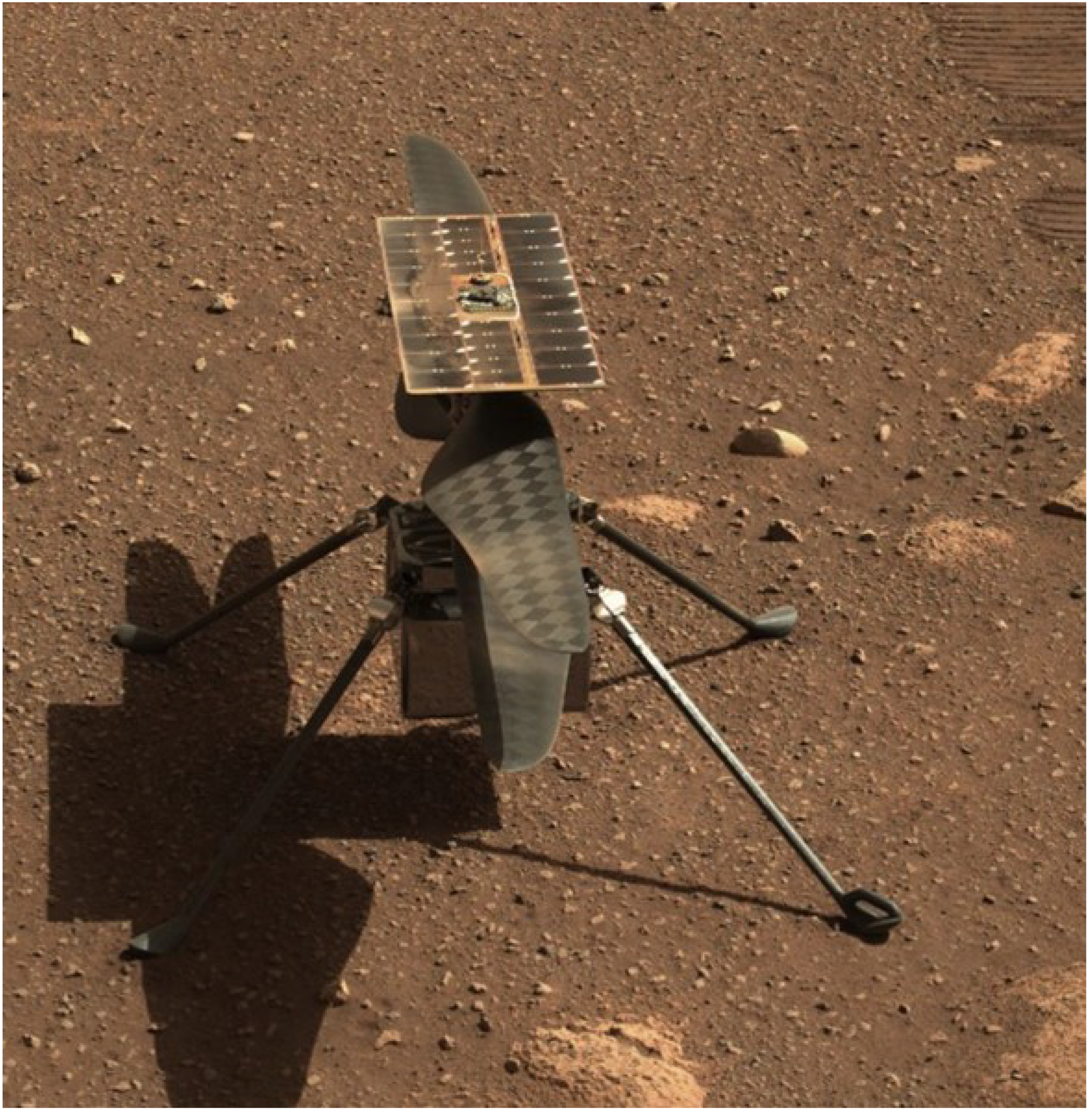

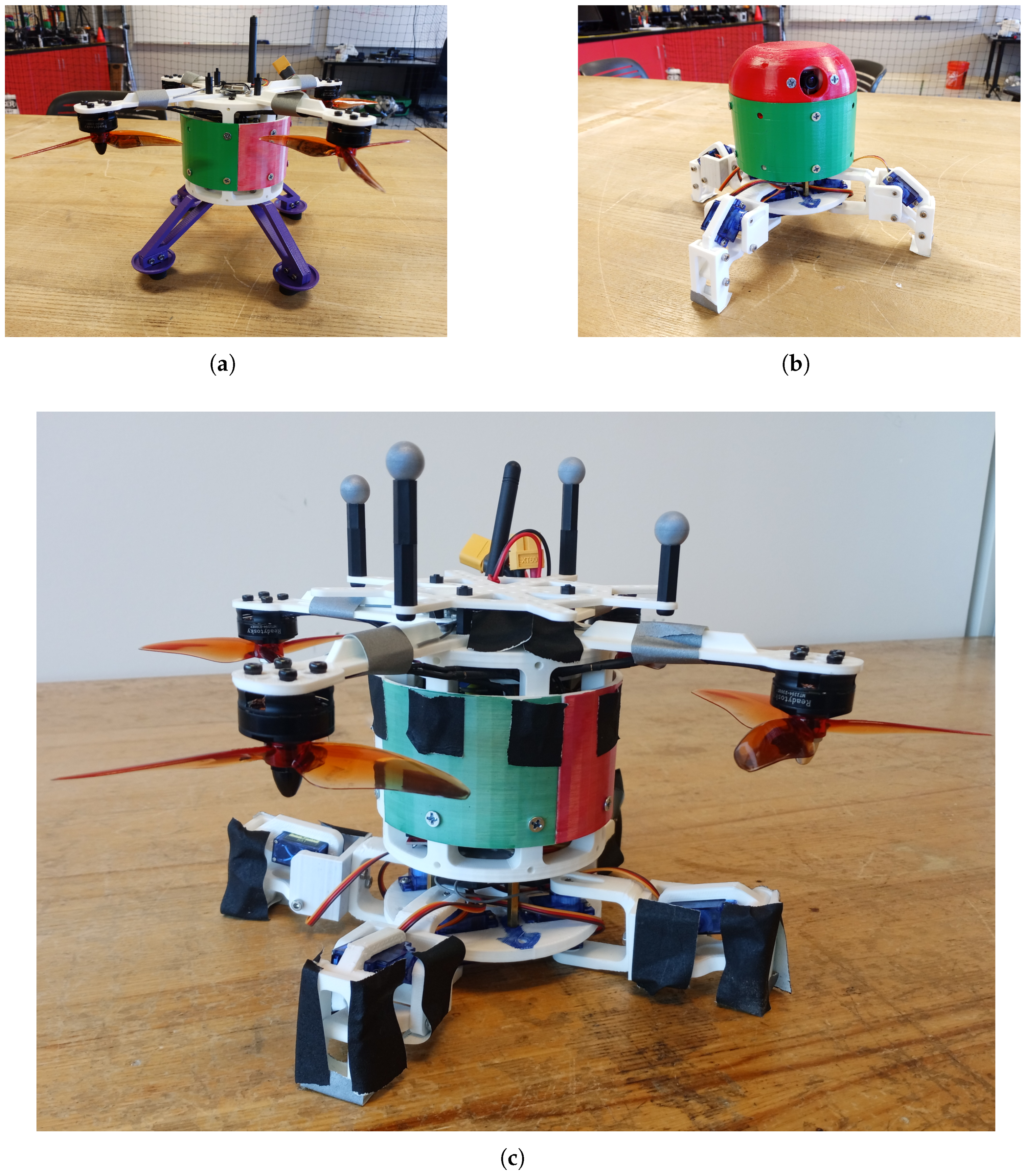
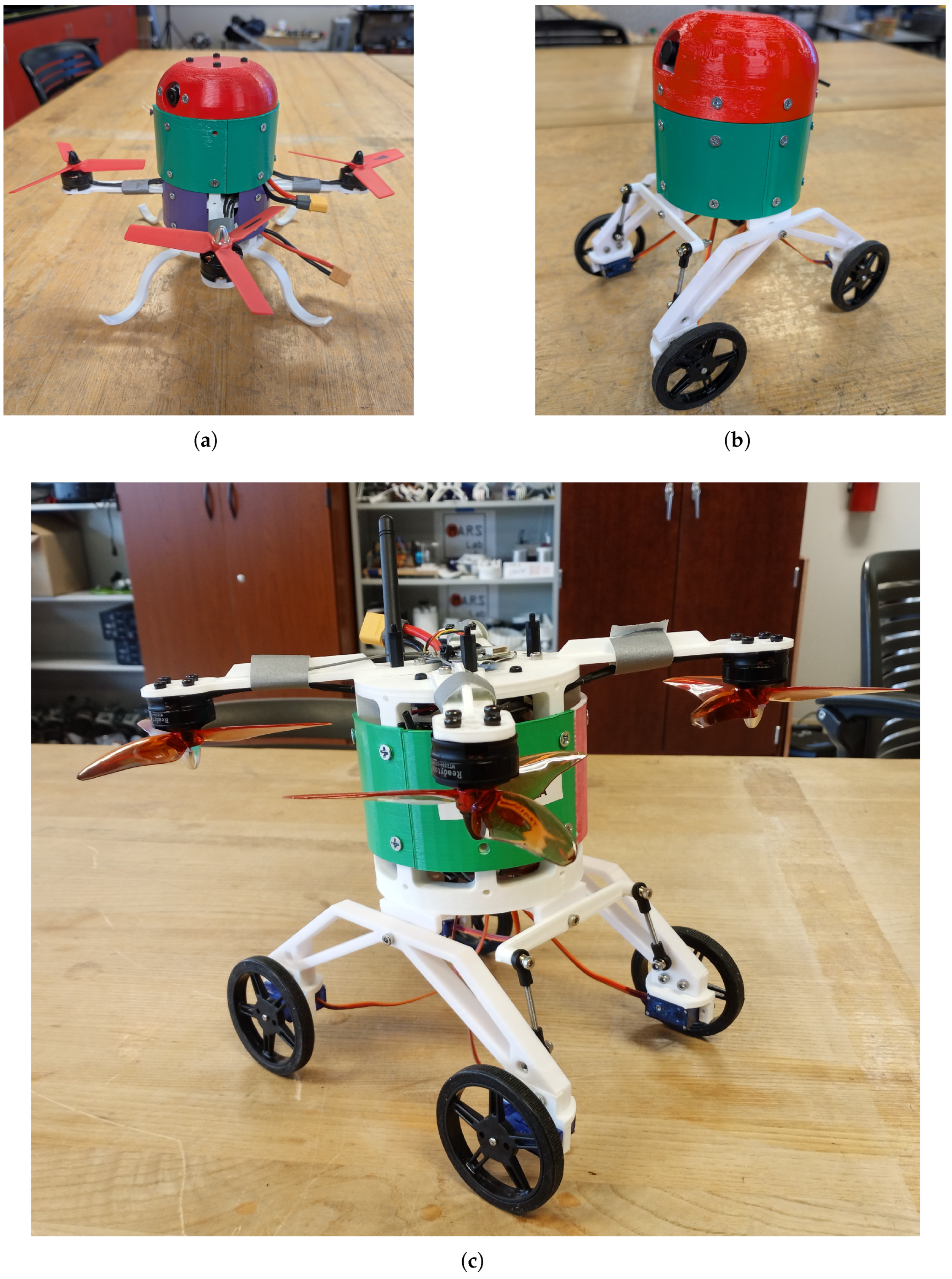
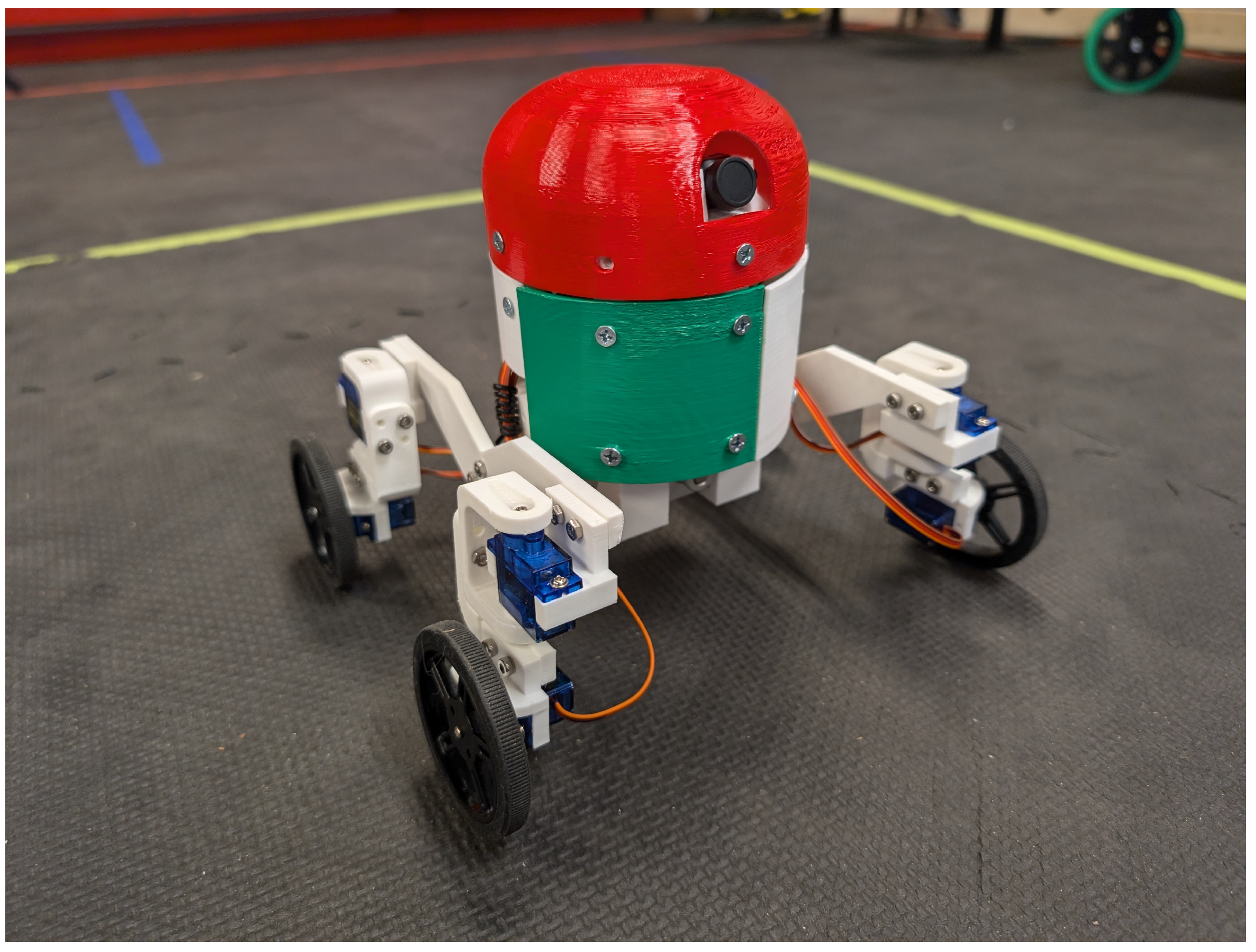
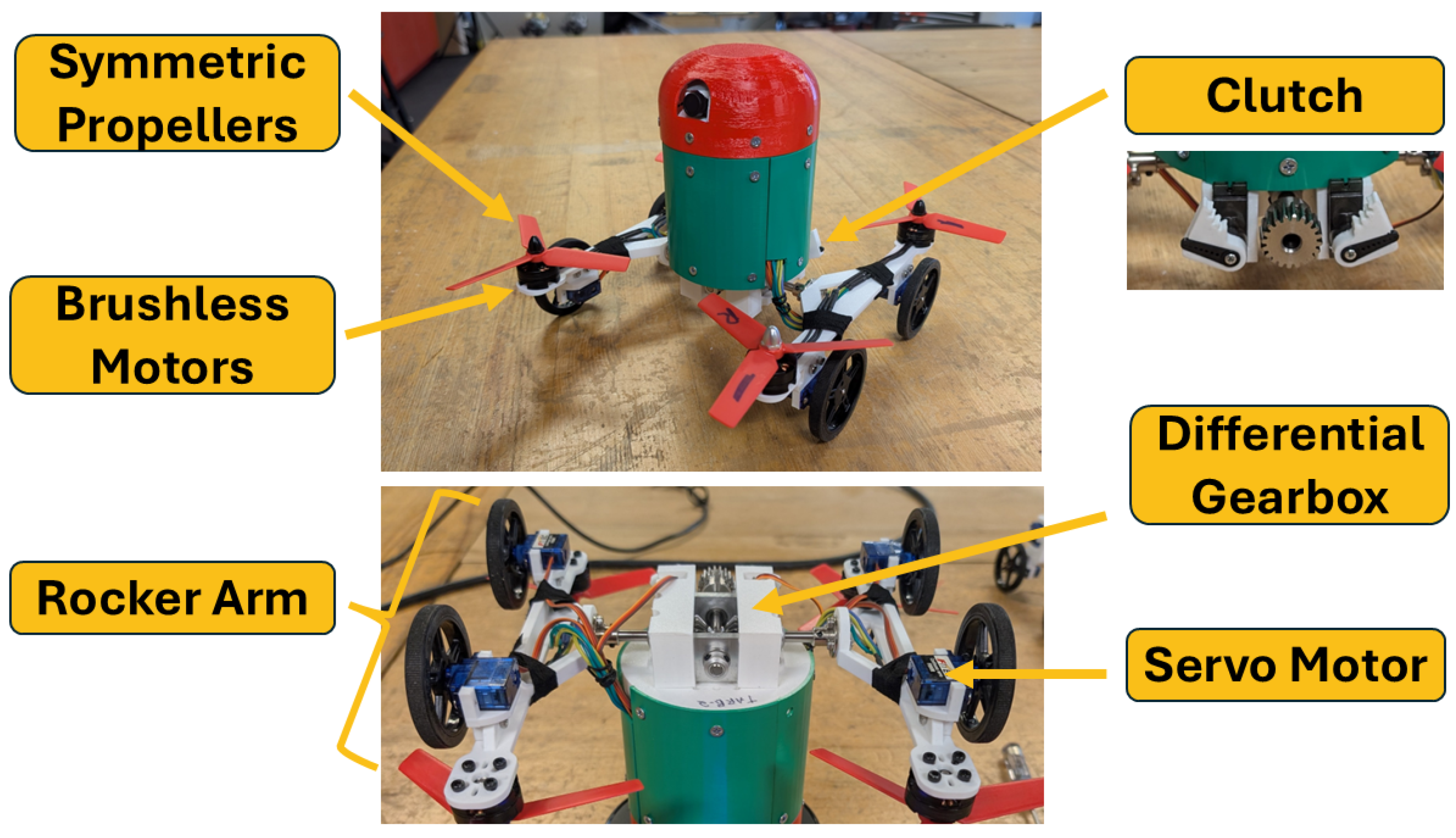

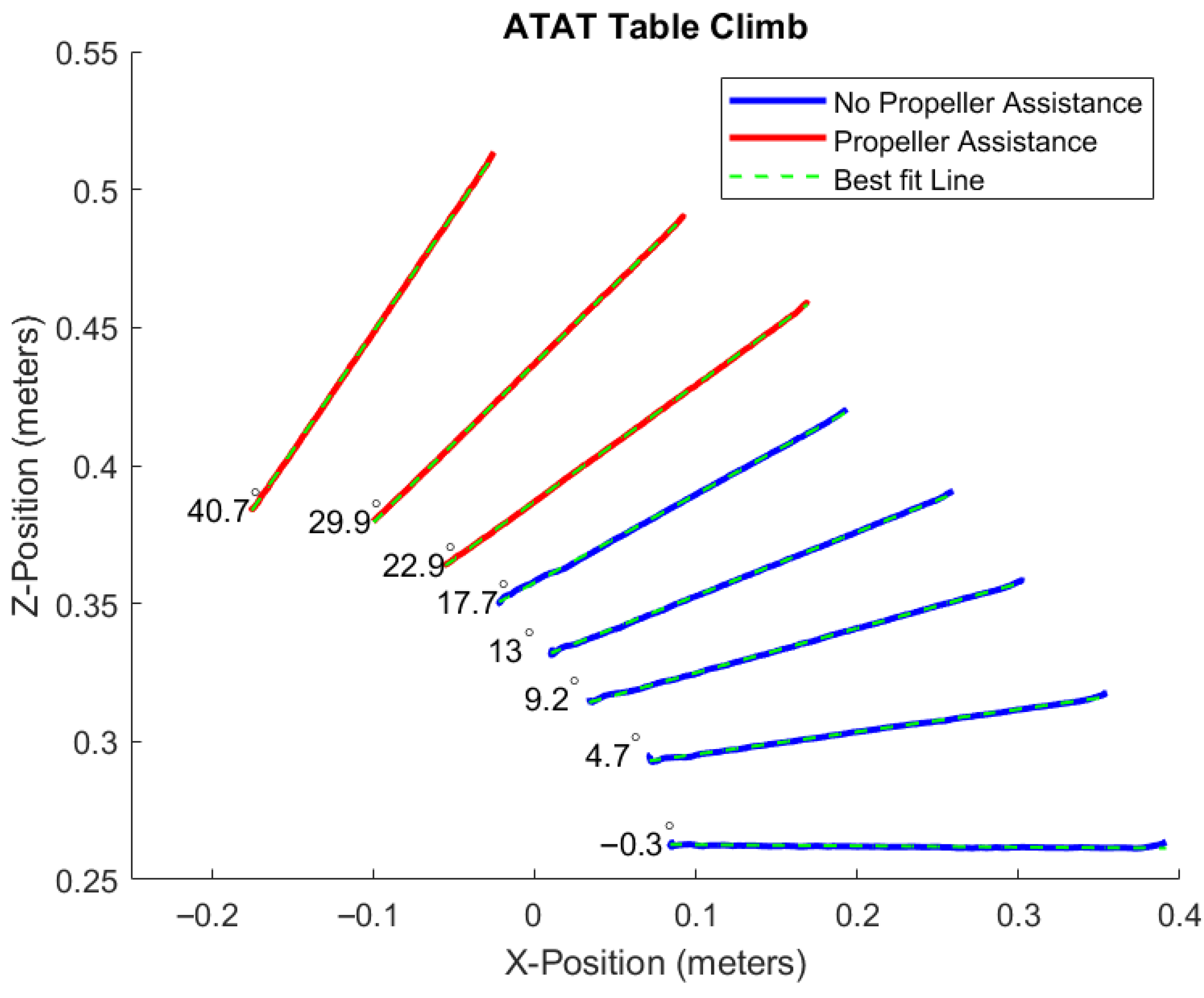








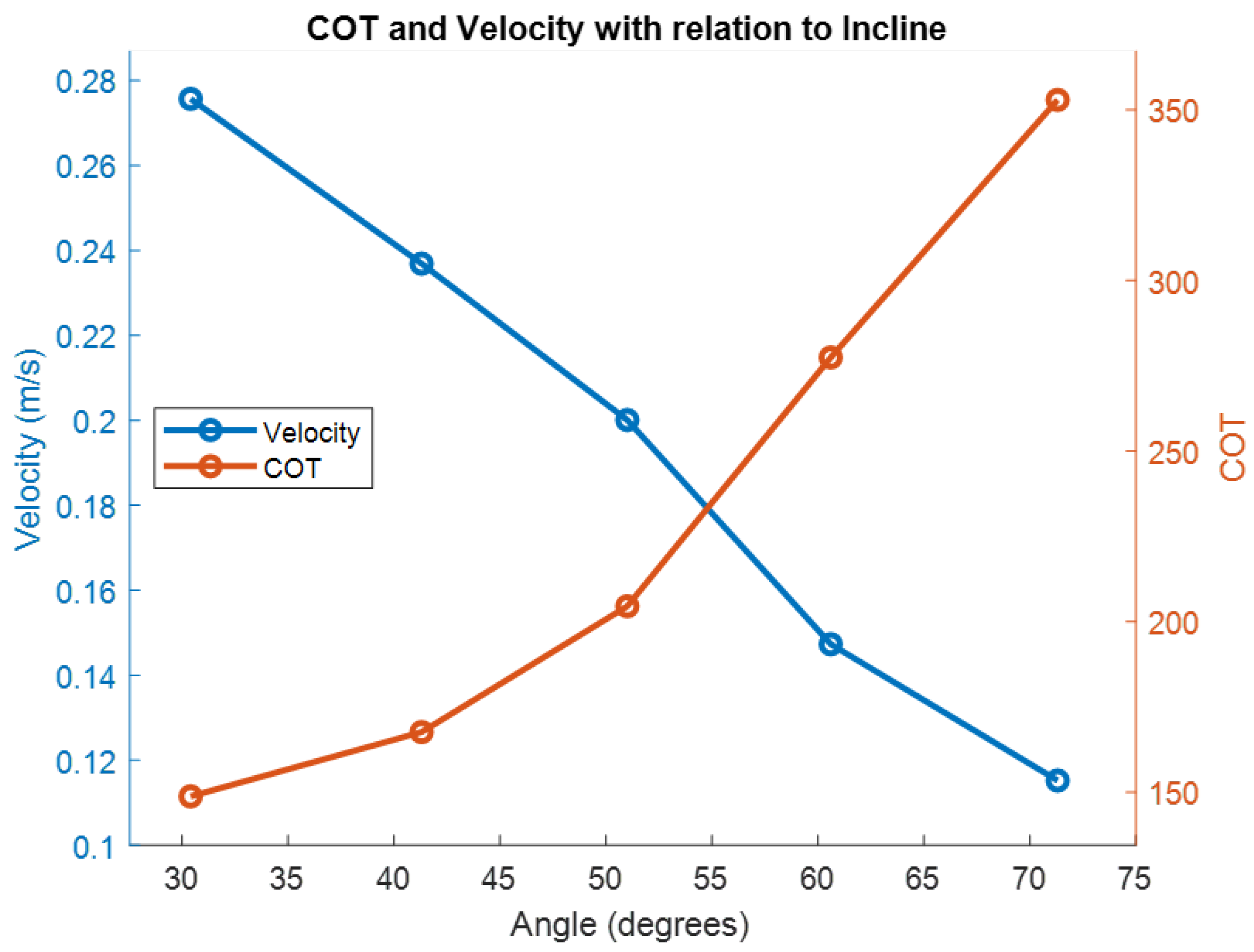

| Name/Citation | Configuration | Space Oriented | Year |
|---|---|---|---|
| Aerial/Ground Dual-Modal Mobile Robot [21] | Heterogeneous | No | 2021 |
| AGAR [20] | Heterogeneous | No | 2021 |
| Drivocopter [18] | Homogeneous | Yes | 2020 |
| FCSTAR [25] | Homogeneous | Yes | 2021 |
| HERALD [19] | Heterogeneous | No | 2014 |
| M4 [24] | Homogeneous | No | 2023 |
| SFH [26] | Heterogeneous | Yes | 2023 |
| SRH [27] | Heterogeneous | Yes | 2023 |
| Underactuated Hybrid Mobile Robot [22] | Heterogeneous | No | 2018 |
| Parameter | Specification |
|---|---|
| Dry Mass (g) | 947 |
| Wheel Controller | Arduino Nano |
| Wheel Motors | MG90D |
| Flight Controller | SpeedyBee f7V3 |
| Propeller Motors | 2204 Brushless |
| Propellers | 5-inch 5b3D3 |
| Battery Voltage (v) | 11.1 (3 s) |
| Battery Storage (Ah) | 1.5 |
| Battery Mass (g) | 130 |
| CanBot Name | ID Code | Dry Mass | Mobility Mode | Figure Number |
|---|---|---|---|---|
| Vertical | CA8-QR1- | 490 g | Air | Figure 4a |
| Quadrotor 1 | FL1 | |||
| Quadruped | CA7-QP1 | 479 g | Ground | Figure 4b |
| Quadruped–Rotor | QR1-QP1 | 698 g | Air/ | Figure 4c |
| Ground | ||||
| Vertical | CA7-QR2 | 507 g | Air | Figure 5a |
| Quadrotor 2 | FL2 | |||
| Cross-Arm | CA7- | 442 g | Ground | Figure 5b |
| Rocker-Bogie | CRB1 | |||
| Hetero Rocker- | QR2- | 625 g | Air/ | Figure 5c |
| Bogie Quad 1 | CRB1 | Ground | ||
| Hetero Rocker- | QR3- | 835 g | Air/ | Na |
| Bogie Quad 2 | QR3-CRB1 | Ground | ||
| Differential | CA9- | 694 g | Ground | Figure 6 |
| Rocker Bogie | DRB1 | |||
| Thrust-Augmented | CA9- | 947 g | Air/Ground | Figure 7 |
| Rocker Bogie | TARB2 | Hybrid | ||
| Coaxial | CW3-CD9- | 1827 g | Ground | Figure 22 |
| Rover 2 | CW4 | |||
| QuadRover | CA9-SQR1 | 359 g | Ground | Figure 22 |
Disclaimer/Publisher’s Note: The statements, opinions and data contained in all publications are solely those of the individual author(s) and contributor(s) and not of MDPI and/or the editor(s). MDPI and/or the editor(s) disclaim responsibility for any injury to people or property resulting from any ideas, methods, instructions or products referred to in the content. |
© 2025 by the authors. Licensee MDPI, Basel, Switzerland. This article is an open access article distributed under the terms and conditions of the Creative Commons Attribution (CC BY) license (https://creativecommons.org/licenses/by/4.0/).
Share and Cite
Chun, C.; Tanveer, M.H. To Boldly Go: Redefining Mobility with Thrust-Augmented Rocker-Bogie CanBots for Simulated Planetary Exploration. Machines 2025, 13, 1050. https://doi.org/10.3390/machines13111050
Chun C, Tanveer MH. To Boldly Go: Redefining Mobility with Thrust-Augmented Rocker-Bogie CanBots for Simulated Planetary Exploration. Machines. 2025; 13(11):1050. https://doi.org/10.3390/machines13111050
Chicago/Turabian StyleChun, Carrington, and Muhammad Hassan Tanveer. 2025. "To Boldly Go: Redefining Mobility with Thrust-Augmented Rocker-Bogie CanBots for Simulated Planetary Exploration" Machines 13, no. 11: 1050. https://doi.org/10.3390/machines13111050
APA StyleChun, C., & Tanveer, M. H. (2025). To Boldly Go: Redefining Mobility with Thrust-Augmented Rocker-Bogie CanBots for Simulated Planetary Exploration. Machines, 13(11), 1050. https://doi.org/10.3390/machines13111050







